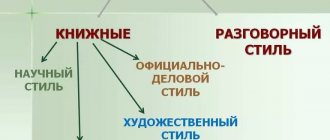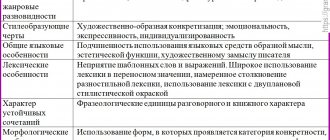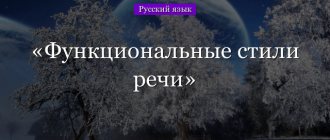Stylistics
is a branch of linguistics that studies the expressive capabilities and means of language, their lexical meaning, as well as the patterns of their use in various linguistic situations and spheres of communication. Stylistics is usually divided into two disciplines: lexical stylistics and functional stylistics. Lexical stylistics examines the expressive means of language, the exact meaning of words and their connotations, lexical compatibility, the phenomena of synonymy and antonymy, phraseology, etc. Functional stylistics explores how language functions in different spheres of human activity, i.e. she analyzes functional styles, their characteristics and features of their use in different communicative situations. In this lesson we will focus specifically on functional styling.
Let us remind you once again that the functional style
or simply
the style of a text
is a certain system of using linguistic means and methods of their organization that accompanies one or another type of human activity and depends on it in its main characteristics.
In the last lesson, we already said that functional styles are divided into two types: conversational style and book styles. Traditionally, there are four book styles: scientific, official business, journalistic and artistic. The main difference between the conversational style and all book styles is that the conversational style is a style of dialogue, a style of spontaneous oral speech, while book styles are codified writing styles that are not used by us in everyday communication. However, many researchers emphasize that the division of styles is arbitrary. Often texts perform several functions at the same time, and therefore they can combine different styles. Despite this, when writing text you need to be very clear about what style you are working in and what style is appropriate based on your goals and your audience. The fact is that the definition of “bad style” often means that the writing style chosen by the author does not correspond to the speech situation and the functions that the text should perform. For example, it is inappropriate to use bookish styles in everyday speech, just as it is inappropriate to write journalistic or artistic texts using official business clericalism, or to use a colloquial style in a scientific text. To help eliminate such errors, let’s look at the main features and characteristics
of each of the functional styles.
Conversational style
Conversational style is, first of all, the style of our everyday communication. Traditionally, it is usually characterized as a style of dialogue and a style of oral speech, although it is also used in writing - in personal correspondence and in personal diaries. Moreover, with the development of the Internet (in particular, with the advent of blogs, social networks, forums), it became obvious that the conversational style is a writing style no less than book styles. Be that as it may, whether we are talking about oral or written speech, the main function of the conversational style is communication. It is always used in informal settings and the speakers are directly involved in the communication. Consequently, the conversational style is characterized by spontaneity, ease, lack of a clear structure and logic of presentation, restructuring of speech on the fly, tolerance of interlocutors regarding mistakes, and emotionality.
As for vocabulary, the conversational style is characterized by the use of a large number of commonly used and neutral words. Since it is most often used when discussing everyday situations, specific vocabulary predominates in it: bus, store, sausage, dishes, sofa. It is also characterized by the presence of so-called colloquial and colloquial vocabulary: usherette, driver, rotten meat, sharomizhnik. The emotionality of speech is created through the use of a large number of words with suffixes that have the meaning of endearment, disapproval, reduction, exaggeration: cat, mommy, sunshine, fool, hulk, bastard. Also, for a conversational style, the use of profanity is quite acceptable. In addition, it often uses idiomatic expressions, proverbs, sayings, and sayings. In addition, it is dominated by pronouns: “So it is, and what is this one doing here?” It also contains many particles and interjections that fill pauses in speech: well, that’s it, yeah, wow. In general, we can say that the conversational style is characterized by lexical redundancy, which is expressed in the presence of repetitions and words that are optional from the point of view of meaning: “Well, I really, really need it! This new boyfriend of yours called again.”
Syntactically, simple sentences predominate in conversational style. Complex sentences or sentences complicated by the use of participial and participial phrases are extremely rare. But elliptical and monosyllabic sentences are often used: “Coffee? - No sugar for me, will you go? - No". Exclamatory and interrogative sentences are also often used: “Leave me alone!”, “Come on?!”, “Wow!” The conversational style is also characterized by free word order.
Scientific style
Scientific style , obviously, is a style of scientific writing or, to use the tracing paper from the English term, academic writing. The last term seems more appropriate to us, because the use of a scientific style is required not only from professional scientists, but also from all people who have one way or another in the academic field - schoolchildren, students, students of online courses, teachers and lecturers. The main functions of the scientific style are communication of scientific results and education. In this regard, within the scientific style it is customary to distinguish scientific-educational and popular science styles, which are primarily aimed at enlightenment.
In general, the scientific style is characterized by accuracy of speech, logical presentation, and emotional neutrality. The scientific style deals primarily with the results of conceptual thinking. Therefore, scientific texts are distinguished by the unambiguous use of concepts, their clear definition, their combination into judgments and conclusions in accordance with the laws of logic, and the presence of transparent argumentation. The scientific style is also characterized by strict structure. Whatever genre we are talking about, a scientific text almost always retains the same structure: an introduction in which a certain thesis is put forward, a main part where its meaning is explained, arguments and examples are given in its favor, counterarguments are examined, and a conclusion. which summarizes the results obtained and describes further directions of research. In this case, the text is divided into paragraphs, paragraphs and chapters according to the principle “one paragraph/paragraph/chapter – one thought”.
The scientific style uses both neutral, common vocabulary and special terms: plasma, interference, peptides, phoneme. A large amount of abstract vocabulary is also used: thesis, evidence, structure, analogy, methodology. Terms borrowed from other languages or words with prefixes of Latin and Greek origin are often used: dehumanization, ultrasound, antibiotic. There is a predominance of nouns and adjectives.
In the scientific style, constructions and turns of communication are of particular importance, designed to emphasize the logical sequence of thoughts and structure of presentation: firstly, secondly, so, therefore, thus, however, meanwhile, in addition, in conclusion, for example.
Regarding syntax, the scientific style is dominated by compound and complex sentences, as well as sentences complicated by participial and adverbial phrases. In addition, passive and impersonal constructions are widespread: “These processes were actively studied twenty years ago, From this we can conclude.”
It is worth noting that the scientific style is usually characterized by reduced emotionality and expressiveness. While this statement is generally true, there are exceptions. They relate primarily to polemical texts, but also apply to the humanities. Historical, philosophical, literary texts often actively use comparisons, metaphors, epithets and other expressive means of language.
Comprehensive analysis of literary text; methodological development in the Russian language (grade 8)
Comprehensive analysis of literary text
K. G. Paustovsky
Present
We brought a box from the barn, filled it to the top with earth and transplanted a small birch tree into it. The box was placed in the brightest and warmest room by the window, and a day later the drooping branches of the birch rose up, she was all cheerful, and even her leaves were already rustling when a draft wind rushed into the room and slammed the door in anger.
Autumn had settled in the garden, but the leaves of our birch remained green and alive. The maples glowed dark purple, the euonymus turned pink, and the wild grapes on the gazebo withered. Even here and there on the birch trees in the garden yellow strands appeared, like the first gray hair of a still young person. But the birch tree in the room seemed to be getting younger. We did not notice any signs of fading in her.
One night the first frost came. He breathed cold air onto the windows in the house, and they fogged up, sprinkled grainy frost on the roofs, and crunched under his feet. Only the stars seemed to rejoice at the first frost and sparkled much brighter than on warm summer nights. That night I woke up from a drawn-out and pleasant sound - a shepherd's horn sang in the darkness. Outside the windows the dawn was barely noticeable blue.
There was no wind, but the leaves kept falling and falling in the garden.
Over that one night, the birches turned yellow to the very tops, and the leaves fell from them in frequent and sad rain.
I returned to the rooms: they were warm and sleepy. In the pale light of dawn there was a small birch tree standing in a tub, and I suddenly noticed that almost all of it had turned yellow that night, and several lemon leaves were already lying on the floor.
The warmth of the room did not save the birch. A day later, she flew around all over, as if she did not want to lag behind her adult friends, who were crumbling in cold forests, groves, and spacious clearings damp in autumn.
Style – artistic
Type of speech – narrative with descriptive elements
Lexical level
The unity of the text is ensured by the following thematic groups of words:
- The theme of autumn: autumn has settled, the maples were burning with a dark purple, the euonymus was turning pink, the wild grapes were drying up, yellow strands, signs of withering, leaves were falling, yellowed to the very tops, frequent and sad rain, several lemon leaves falling in the cold forests, damp in the autumn, first gray hair first frost.
- Time: autumn, at night, the first frost, warm summer nights, the dawn turned blue, in the pale light of dawn, every other day, younger, signs of withering, the first gray hair, the first frost.
The themes of autumn and time are naturally related to each other, since autumn is one of the seasons. However, in the text the theme of autumn grows and takes on a special, independent meaning. The closeness and parallelism of themes is indicated by intersecting lexical units: the first gray hair - yellow strands - the first frost.
- Space: in the room by the window, in the garden, outside the windows, rooftops, (implicitly) in the sky - the stars sparkled.
The interior space of the house's rooms is contrasted with the exterior space of the garden. Both spaces seem to go back to some higher, sacred space (the sky and the stars), where the supreme laws governing the life of man and nature are established.
- Color: vocabulary related to color can be divided into 3 groups.
| Yellow and green | Red color | Blue |
| the leaves remained green and alive yellow strands turned yellow a few lemon leaves | were burning dark purple turned pink | the dawn was blue in the pale light of dawn the stars sparkled |
- Sounds: leaves rustled, a door slammed, crunched underfoot, a long and pleasant sound made a shepherd's horn sing.
- Feeling: in a bright and warm room, it was warm, sleepy, in cold forests, in damp meadows.
Adjacent to the theme of the antithesis of two spaces and continues it. Warmth and comfort, the sleepy, softened state of a person’s internal space are contrasted with the cold and dampness of autumn nature.
7. Feelings: cheerful, in our hearts, rejoiced.
In the given fragment the following tropes and stylistic figures are used:
Personifications: the branches of the birch tree rose, she was all cheerful, her leaves were already rustling, when a draft wind rushed into the room and slammed the door in her hearts, autumn settled in the garden, the birch tree was getting younger, (frost) breathed cold on the glass in the house, sprinkled grainy frost the roofs crunched underfoot, only the stars seemed to rejoice at the sad rain.
Personification plays an important role in the text; this means of artistic expression is meaningful, as it emphasizes the living soul of nature, the unified essence of nature and man.
Comparisons: yellow strands, like the first gray hair of a still young person, leaves fell from them in frequent and sad rain.
The first comparison reveals the parallelism between the life of nature and man. The second creates a sad autumn mood.
Antitheses: yellow strands appeared on the birch trees in the garden - the birch tree in the room seemed to be getting younger, it showed no signs of wilting; warm room - cold forests, groves; birch leaves remained green and alive - shriveled
wild grapes on the gazebo.
All artistic means: personifications, comparisons, and antitheses “work” to create images that help to understand the main idea of the text: about the unity of all life on earth, about the laws of life that cannot be changed or overcome, about the wisdom of nature.
Morphological level
Since we have before us a narrative with elements of description, the dominant parts of speech in the text are verbs, qualitative adjectives and nouns. The main part of the verbs are past perfect verbs, whose function is to depict a sequence of completed actions.
The repetition of the imperfective verb fell and fallen is intended to express the duration of the action.
Qualitative adjectives acting as epithets create bright, memorable images and the autumnal mood of the text.
Syntactic level
Compound and complex sentences help convey narrative intonation and create a complex image of the world in which human life is closely intertwined with the life of nature. The non-union sentences create a complete, dynamic description: the maples were burning dark purple, the euonymus was turning pink, the wild grapes were drying up on the gazebo, which confirms us in the idea of the inevitability of the embodiment of the basic law of life.
Impersonal sentences, conveying the state of nature (there was no wind) and man (it was warm and sleepy), are an artistic means of depicting the unity of the world of man and nature at the syntactic level.
Formal business style
Official business style is the style of documents: international treaties, government acts, laws, regulations, official correspondence, business papers. It serves the sphere of administrative-legal and administrative-economic activities. Its main functions are communication and prescription. Depending on the scope of application (legislation, justice or management), three substyles are distinguished within the official business style: legislative, jurisdictional and administrative.
The official business style is distinguished by accuracy, conciseness, evaluative and emotional neutrality, and standardization. This is the only style that is characterized not only by the presence of an accepted structure, but by the use of regulated samples - forms. In addition to forms, the effect of standardization is also created through the use of stamps and clericalism: based on the facts presented, it is established, it is ordered to compensate for the damage, in the past year, it is necessary to provide assistance, I ask you to take measures to eliminate the shortcomings, we bring it to your attention, enter into legal force.
In the official business style, nouns predominate, and they are typically combined into long chains: “measures to regulate labor productivity at enterprises in conditions of economic stagnation.” Both neutral and special official business vocabulary are used: “cassation, protocol, civil status act, invoice.” People are referred to by their title or role: “employer, plaintiff, defendant, chief marketing officer.” The obligatory-prescriptive nature of speech is created with the help of performative verbs and short adjectives with the meaning of modality, as well as verbs in the imperative mood: “I order, I decree, it is necessary, I am obliged, I must, I should.”
In the official business style, complex and complex sentences predominate, in particular complex sentences that convey the relationship of conditions, causes and consequences. Constructions with nominal prepositions are used in large quantities: “in connection with, for the purpose of, on the basis of, in order to avoid.” The most common word order used is direct word order.
Where is it drawn?
Where can a dear artist paint his creation? We will omit the canvas and the tree; these paintings will be in other divisions, but we will consider non-standard solutions.
Street art
This includes any street art. From graffiti to performances.
Airbrush
Airbrushing can be done on any surface, but the airbrush is strictly the tool. What kind of airbrushing have you seen?
From my own experience, I can say that an airbrush allows you to paint on almost any surface. The pictures turn out photorealistic or, at least, nice. Do you know how to use an airbrush?
Decorative painting
It would seem, what kind of art is there in stamps on the wall or patterns on wallpaper? But their creators are also artists and want well-deserved fame.
After all, wallpaper is clearly in more homes than paintings.
Journalistic style
The journalistic style is associated primarily with the socio-political sphere and is the style of the media. Its main functions are to inform, influence and educate. It includes four substyles: newspaper-journalistic, propaganda, official political-ideological, mass political. Due to its heterogeneity and variety of tasks, journalistic style does not lend itself well to a unified description. Therefore, we will note only the most general features.
Since the journalistic style is used primarily in journalism, researchers note that it must necessarily be characterized by documentary accuracy and logic. However, in practice, these are more likely some wishes than the real state of affairs: often authors sacrifice accuracy and logic in order to produce the greatest effect on the reader. It is undeniable that the journalistic style is characterized by evaluativeness and emotionality. The author addresses the reader not only to convey certain information to him, but also to form in him some attitude towards this information.
In this regard, the form, appearance, and method of presenting the text acquires special significance. Unlike scientific and official business styles, genres of journalism rarely have a clearly defined structure. However, in journalism, the expressive abilities of dividing text into parts using headings, subheadings, highlighting individual sentences in large font, etc. are actively used. Their goal is to hook the reader, to get him hooked.
By and large, all types of vocabulary are used in the journalistic style: neutral, bookish, colloquial, scientific, official business. It all depends on the topic of the text and its target audience. In the journalistic style, one can note the predominance of socio-political and civil-pathetic vocabulary: “social consciousness”, “market economy”, “vertical of power”, “civil society”. The so-called newspaperisms are also used, which are often found in the media, but are practically not used in other styles: “agrarian, werewolves in uniform, brain drain, leavened patriotism.” In order to give special expressiveness to speech, neologisms, archaisms, historicisms, and exoticisms can be used. The words are often used in their expanded meaning: “political frontier”, “geography of conflict”. Phraseologisms and idiomatic expressions are actively used. The following tropes are also common in the journalistic style: metaphors, comparisons, epithets, hyperboles, etc. There are frequent cases of the use of language games and irony.
As for syntax, the journalistic style contains both simple and complex sentences. At the same time, in a journalistic style, one should avoid excessively complicating the syntax by introducing many participial and participial phrases or subordinate clauses. The journalistic style strives for brevity and the greatest impact on the reader, therefore it is characterized by elegant syntactic constructions. For example, using colons and dashes instead of conjunctions, elliptical sentences, breaking one long sentence into several shorter ones. Rhetorical questions and exclamations are also often used. If the text is of a propaganda nature, then it contains imperatives and adjectives with a modal meaning.
Art style
Fiction , as the name suggests, is a style of fiction. All researchers note the particular complexity of its study and characteristics. The fact is that fiction is extremely heterogeneous, plus it can use the linguistic means of all other functional styles. Therefore, it is almost impossible to identify any common features inherent in all literary texts. Perhaps the only thing that can be said with certainty about artistic style is that its main function is aesthetic impact. Whatever specific means are used in a particular text, they all work precisely for this function.
At the same time, means of expression can be very different. Firstly, the form of the text is of great importance. Fiction has created the largest number of genres, each of which has its own structure, its own characteristics and rules of construction. Moreover, the form in this case always carries a semantic load. Secondly, the artistic style actively exploits various types of vocabulary and the effects of their combination. Thirdly, the artistic style is characterized by increased emotionality and expressiveness due to the use of various tropes. As with genres, fiction has developed the most developed system of tropes. Fourthly, the artistic style pays great attention to the effects of synonymy, antonymy, connotations, and language games. Finally, completely different syntactic structures can be used in a literary text - from extreme simplification to extreme complication. The so-called author's punctuation, which best conveys the main idea, is acceptable.
Artistic style of speech: distinctive features and main features
The main features, distinctive features and features of the artistic style include the following characteristics:
- Imagery and emotionality. With the help of words and colorful images, the author of the work conveys the whole gamut of feelings and emotions.
- Aesthetics. Creation of "beautiful".
- Individuality. Each author, one way or another, has his own unique and inimitable style of storytelling.
- Subjectivity. The reader (listener) perceives the work and the entire environment through the author’s vision.
- Use of stylistically colored vocabulary.
- Use of figurative and expressive means and a variety of syntactic structures. Literary works use figures of speech and tropes (metaphor, allegory, personification, repetition, inversion, irony, etc.). The site has a detailed article “How to Write a Persuasive Text: Rhetorical Devices, Figures of Speech and Tropes.”
- An abundance of adjectives and participles to create the necessary image.
- Pronouns are often used (this gives the text sincerity).
- Use of other styles, especially colloquial (for example, the use of scientific terminology or slang words).
- Using words in a figurative meaning.
- There are more words of a wide range of use and fewer highly specialized words (only for reliable transmission of some aspects of life, for example, to describe military operations).
How to distinguish between styles?
To make it easier for you to navigate the style features described above, we have presented their main characteristics in the form of a brief table.
| Style | Genres | Peculiarities | Language means |
| Colloquial | Conversation, story, letters, diaries, notes, proverbs, sayings | Ease, simplicity, emotionality, imagery, concreteness | Colloquial vocabulary, phraseology, simple sentences, incomplete sentences, use of interjections, interrogative and exclamatory constructions |
| Official business | Laws, orders, instructions, reports, regulations, stationery | Accuracy, standardization, emotional and evaluative neutrality | Stationery, cliches, official business terminology, complex sentences |
| Journalistic | Article, sketch, essay, report, feuilleton, interview, speech, proclamation, leaflets | Documentary accuracy, logic, evaluativeness, emotionality | A combination of book and colloquial vocabulary, socio-political vocabulary, newspaperisms, rhetorical questions and exclamations, the use of tropes |
| Scientific | Article, report, lecture, review, review, annotation, abstract, dissertation, textbook, dictionary | Accuracy, abstractness, logic, emotional neutrality | Terminology and professional vocabulary, abstract vocabulary, complex sentences, expressions of communication, passive and impersonal constructions |
| Art | Novel, story, short story, poem, ballad, poem | Artistic imagery, emotionality, evaluation | Tropes, metaphors, imagery, mixing different styles, language games |
Text style examples
Below are some examples. Determine which style each text belongs to.
1
And she took it and drank another hundred grams. She drank while standing, throwing her head back like a pianist. And after drinking, she exhaled everything from herself, everything that was sacred in her, she exhaled everything. And then she bent like a bastard and began wave-like movements with her hips - and all this with such plasticity that I could not look at her without shuddering...
Of course, you will ask, you, unscrupulous ones, will ask: “So, what, Venichka? She……..?" Well, what should I answer? Well, of course she……….. ……….! Of course she wouldn’t……………….! She told me directly: “I want you to powerfully hug me with your right hand!” Haha. “Powerfully” and “with the right hand”?! - and I’m already so pumped up that I not only want to hug her imperiously, but I want to touch her torso - and I can’t, I keep missing her torso...
- Well! play with cool sides! – I thought, diluting it and drinking it. Play, seductress! Play, Cleopatra! Play, you plump whore who has exhausted the poet’s heart! Everything that I have, everything that maybe I have - I throw everything today on the white altar of Aphrodite!
That's what I thought. And she laughed. And she went to the table and drank, in one gulp, another hundred and fifty, for she was perfect, and there is no limit to perfection...
Find out what style
Answer:
art style. An excerpt from the book “Moscow-Petushki” by Venedikt Erofeev. The artistic style is indicated by special emotionality and imagery, which are achieved through a mixture of high book and colloquial vocabulary, the use of tropes and author's punctuation.
2
In fact, our great teachers, such as Michelet or Fustel de Coulanges, taught us to understand this long ago: the subject of history is man. Let's be more precise - people. The science of diversity is better suited not to the singular number, which is favorable for abstraction, but to the plural, which is a grammatical expression of relativity. Behind the visible outlines of the landscape, tools or machines, behind the most seemingly dry documents and institutions, completely alienated from those who established them, history wants to see people. Whoever has not mastered this can, at most, become a laborer of erudition. A real historian is like a fairy-tale cannibal. Wherever there is the smell of human flesh, he knows that prey awaits him.
Find out what style
Answer:
scientific style. An excerpt from Mark Blok’s work “Apology for History or the Craft of the Historian.” The scientific nature of the style is achieved through the use of book vocabulary, scientific terms, abstract concepts, complex sentences, and introductory phrases.
3
Gentlemen judges, gentlemen jurors! About a month ago, in Spasskaya Street, in Dmitrievsky’s house, a great misfortune occurred. The family, whose only support was Alexey Ivanovich Ryzhov, consisting of his wife and four children, suddenly and unexpectedly became orphaned: the head of this family was deprived of his life. He lost his life not surrounded by the care and participation of his relatives, not blessing his children, but accompanied by their desperate cries and falling at the hands of someone close and indebted to him. This close and obligated person is currently in front of you and it is up to you to decide his fate.
The essential circumstances of this case are so simple in themselves, so obvious, it seems to me, that pointing them out in detail and examining them again before you seems unnecessary, or, better said, would seem unnecessary if some secondary circumstances had not been added to them and thanks to they did not raise some questions that require a more detailed consideration of all the data in the case. When a crime is committed, then only in the first minutes the events in which it was expressed remain in their original, unobscured form, and then on the part of the pursuers, efforts to illuminate and reveal its criminal meaning, on the part of the accused to surround it with all kinds of data and arguments in their favor, significantly complicate matter, sometimes even makes it difficult to parse it. In this way, in each case, around the real, primary circumstances, secondary circumstances arise, so to speak, layers, which sometimes obscure its simple and clear outlines. In some cases, the prosecutorial authority only has the responsibility of clearing the case of these extraneous, extraneous circumstances, removing this extraneous, extra bark, and after removing it, the case turns out to be simple and uncomplicated. I will now begin removing this bark.
Find out what style
Answer:
formal business style. Excerpt from the court speech of A.F. Koni “In the case of the murder of State Councilor Ryzhov.” An official business style is indicated by the presence of special vocabulary, cliches and clericalism related to judicial office work, as well as complicated syntax.
4
A year has passed since the Lena events and the first, decisive rise of the revolutionary labor movement after the coup of June 3. The Tsar's Black Hundred and the landowners, a horde of officials and the bourgeoisie celebrated the 300th anniversary of the robbery, Tatar raids and disgrace of Russia by the Romanovs. The Fourth Duma got ready and began its “work”, not believing in it itself and having lost its former counter-revolutionary energy. Confusion and boredom have taken hold of a liberal society, which half-heartedly churns out calls for reform - and at the same time recognizes the impossibility of even a semblance of reform.
And so, the May rally of the working class of Russia - first giving a rehearsal in Riga, and then, on the first of May according to the old style in St. Petersburg - this May rally, like lightning in a gloomy, dull, dreary atmosphere, cut through the air. Before hundreds of old revolutionaries, who had not yet been finished off and broken by the persecution of the executioners and the renegade of their friends, before millions of the new generation of democrats and socialists, the tasks of the coming revolution arose again, in all their greatness, and the forces of the leading advanced class were outlined.
Find out what style
Answer:
journalistic style. Excerpt from an article by V.I. Lenin "May Day of the Revolutionary Proletariat". The text is distinguished by the use of socio-political vocabulary, newspaperisms, the use of words in an expanded meaning, characteristic of the journalistic style, and the desire to influence the reader.
5
So, I was brought to the Olympic...
Damn, what nostalgia! Once upon a time, about twenty years ago, I came here from Alma-Ata with Valerka Smolyaninov, now living in St. Petersburg, we loaded ourselves with books and, with our eyes bulging, read them on the train to Alma-Ata - to sell them there at the market and... and compensate for the cost of the trip + those books that they left for themselves. We were lousy businessmen...
Once upon a time, about twenty years ago, I came here from Alma-Ata with Valerka Smolyaninov, now living in St. Petersburg, we loaded ourselves with books and, with our eyes bulging, read them on the train to Alma-Ata - to sell them there at the market and... and compensate for the cost of the trip + those books that they left for themselves. We were lousy businessmen...
Then the book market in Olimpiysky was a seething, crowded cesspool - where in one day copies of anything and anyone were sold, sometimes small fortunes were made, and more often large ones were lost.
Now it is small, intimate, half of the market is the sale of all sorts of calendars, pillows, homemade products, toys, books like “How to miraculously improve your liver health” and “Celery is a friend of your spleen!” Of the books, half are all sorts of “Stalkers” and other books from the series “The whole world is dead, but we are moving.” But there are also a few normal ones - those, you know, who are not similar to each other.
I saw and bought the new Terry Pratchett. - “Smack!” In fact, I’ve already read it - under the titles “Boom” and “Bryak”, if I’m not mistaken. In the form of self-made translations on the network. Well, I couldn’t wait for the official release of the book, considering that the amateur translation was readable. 
Now he has made up for his wrongdoing. By the way, I was surprised by the price at the Olimpiyskiy - 200 rubles. There is a clear feeling that the price in bookshops is one and a half times higher...
By the way, I was surprised by the price at the Olimpiyskiy - 200 rubles. There is a clear feeling that the price in bookshops is one and a half times higher...
Find out what style
Answer:
conversational style. Note from Sergei Lukyanenko's LiveJournal. The text describes an everyday situation and is based on the use of vocabulary and syntax characteristic of a conversational style.
The meaning of the word artistic
Khudozhestvenny is the oldest cinema in St. Petersburg and in Russia.
From “Biofon” to “Saturn” and back to “Artistic”.
From “Biofon” to “Saturn” and back to “Artistic”.
The first mention of the house on Nevsky 67 that has survived to this day dates back to 1903, although the building itself was built much earlier and managed to change three owners before 1840, when the merchant Kozulin became its owner. The cinema in this building was designed and built by the architect Artyom Georgievich Dzhorogov.
On October 12, 1907, the newspaper “Birzhevye Vedomosti” for the first time mentioned a unique cultural and entertainment institution “Biofonauksetofon”, where audition sessions were held for drama, opera, operetta and pop artists. This “theater,” whose name was soon shortened to “Biofon,” gave a performance every hour and a half until midnight, and on holidays until one in the morning. Entrance fees varied from 50 kopecks to one and a half rubles, which was a lot of money at that time. In October 1909, “Biofon” was renamed “Saturn” and in its new capacity became a cinema, located on the second floor of the building.
Of particular interest is the collaboration with the Saturn cinema by Alexander Drankov himself, the first Russian film director, creator of “Ponizovaya Volnitsa” (1908), a film - a pioneer of Russian cinematography, who also filmed Leo Tolstoy in Yasnaya Polyana. This film, shown exclusively at Saturn, over time became a source of special pride for our documentary filmmakers. The owner of the Saturn cinema was a hereditary nobleman and famous St. Petersburg businessman Yaroslav Frantsevich Krynsky.
In 1933, the cinema received the name “Cinema for the Masses”, which it retained until 1935, when it became “Art”, immediately becoming one of the most visited cinemas in the city. “Artistic” specialized in comedy and musical films. Old-timers say that in the late 30s a jazz orchestra performed there under the direction of Yakov Skomorovsky and Klavdiya Shulzhenko sang. A special page in the history of Khudozhestvenny is connected with the Great Patriotic War.
The halls on Nevsky were filled even during the blockade. There was only one break in the cinema's work, when during the terrible winter of 1941-42. The electricity supply has stopped. But, starting in the spring of 1942, it was possible to watch movies again. The sessions were sometimes interrupted by an air raid siren, and the audience obediently followed to the bomb shelter. And with the “air raid all clear” signal they returned to the cinema hall. In the 70-80s, exhibitions of various subjects were constantly held in the foyer of the Khudozhestvenny. The magnificent master Tatyana Ostrogorskaya also showed her work (she created costumes for such films as “A Dog in the Manger” (1977), “D’Artagnan and the Three Musketeers” (1979), “The Pious” (1983), “The Demidovs” (1983) , "Don Cesar De Bazan" (1989)).
The 80s were the most fruitful and eventful time in the history of cinema. In March 1985, Khudozhestvenny was one of the five Leningrad cinemas that became winners of the All-Union Socialist Competition.
It is not clear when the last session was noted, since no one simply noticed it. The once bustling film life froze for many years. To rise, fortunately, in November 2005, like a Phoenix from the ashes. The fact that the revived Khudozhestvenny cinema opened on November 18, 2005, along with the start of the next, sixteenth week of Finnish cinema in St. Petersburg, seems symbolic to us, because 40 years have passed since the first such Week, dedicated to the days of the city Turku in Leningrad.
The cinema has 7 halls.
Halls 1,2,3,4:
— each has 130 seats.
— Soft comfortable chairs with adjustable backs, equipped with folding armrests, equipped with holders for glasses with drinks.
— BARCO film projectors are installed in halls 1 and 2.
— In the 3rd and 4th halls there is a BARCO digital film projector and equipment for 3D screening - Master Image.
— Sound equipment: DOLBY CP650XO processor, OUTLINE speaker system, CROWN amplifiers.
Premier Hall:
The hall is intended for holding premiere screenings of films and festivals.
— Hall for 245 seats
— In front of the screen there is a stage equipped with microphones for premiere screenings, presentations and festivals.
— Comfortable chairs with adjustable backs, equipped with folding armrests, and equipped with stands for glasses with drinks.
— BARCO digital film projector, equipment for 3D screening – Master Image.
— Sound equipment: DOLBY CP650XO sound processor, OUTLINE speaker system, CROWN amplifiers.
Hall "Small"
— A cozy hall with 20 seats.
— Comfortable chairs with adjustable backs, equipped with folding armrests, and equipped with stands for glasses with drinks.
— BARCO digital cinema projector.
— Sound equipment: DOLBY CP650XO sound processor, OUTLINE speaker system, CROWN amplifiers.
— Unique movie screen (3000 by 1500 mm).
VIP room
— A cozy hall with 30 seats, decorated in burgundy tones. This room has soft sofas for two and single chairs.
— In front of each sofa there is a table with a telephone, through which you can place an order from the assortment of the Anime sushi bar.
– digital film projector CHRISTIE, equipment for 3D display – Master Image
— Sound equipment: DOLBY CP650XO processor, OUTLINE speaker system, CROWN amplifiers









